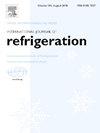Influence of asymmetrical features of scroll plates on thermodynamic processes and orbiting scroll dynamic characteristics of electric vehicle scroll compressors
IF 3.5
2区 工程技术
Q1 ENGINEERING, MECHANICAL
International Journal of Refrigeration-revue Internationale Du Froid
Pub Date : 2025-03-12
DOI:10.1016/j.ijrefrig.2025.03.020
引用次数: 0
Abstract
The electric scroll compressor is the main energy-consuming component of the thermal management system of electric vehicles and has been widely used for this application. To meet the needs of the entire vehicle, the scroll compressor is developing towards miniaturization. However, this trend often causes the compressor to have shorter scroll wraps and may require high rotational speeds for operation. As a result, changes in the structures of scroll plates have already appeared, including different lengths between fixed and orbiting scroll wraps, an off-center discharge port, asymmetrically positioned bypass ports, a crescent groove at the start of the orbiting scroll, and scroll wrap offsetting. Although these features, referred to as asymmetrical features in this paper, fundamentally change the thermodynamic process within the scroll chambers and dynamic characteristics of the orbiting scroll plate, no study has comprehensively discussed them or their impacts. Clarifying the mechanism and extent of these features is a worthwhile endeavor that will help guide the future design and optimization of scroll plates. Therefore, a mathematical model of the thermodynamic process and dynamic analysis was established in this study. An experiment was then conducted to confirm the model validation. Four working conditions under different pressure ratios and rotational speeds were selected to perform the simulation. The impacts of the working conditions and asymmetrical features on pressure and temperature changes within the scroll chambers and changes in the forces and moments acting on the orbiting scroll plate were compared and analyzed.
求助全文
约1分钟内获得全文
求助全文
来源期刊
CiteScore
7.30
自引率
12.80%
发文量
363
审稿时长
3.7 months
期刊介绍:
The International Journal of Refrigeration is published for the International Institute of Refrigeration (IIR) by Elsevier. It is essential reading for all those wishing to keep abreast of research and industrial news in refrigeration, air conditioning and associated fields. This is particularly important in these times of rapid introduction of alternative refrigerants and the emergence of new technology. The journal has published special issues on alternative refrigerants and novel topics in the field of boiling, condensation, heat pumps, food refrigeration, carbon dioxide, ammonia, hydrocarbons, magnetic refrigeration at room temperature, sorptive cooling, phase change materials and slurries, ejector technology, compressors, and solar cooling.
As well as original research papers the International Journal of Refrigeration also includes review articles, papers presented at IIR conferences, short reports and letters describing preliminary results and experimental details, and letters to the Editor on recent areas of discussion and controversy. Other features include forthcoming events, conference reports and book reviews.
Papers are published in either English or French with the IIR news section in both languages.

 求助内容:
求助内容: 应助结果提醒方式:
应助结果提醒方式:


